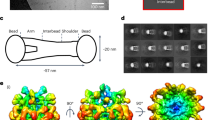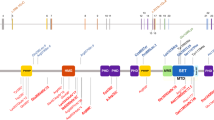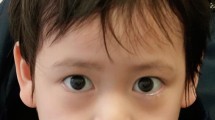Abstract
We report on a patient with developmental delay and several facial characteristics reminiscent of Wolf–Hirschhorn syndrome, who carries a terminal 4p16.3 deletion of minimally 1.691 Mb and maximally 1.698 Mb. This deletion contains the FGFRL1 gene, but does not include the WHSC1 gene. Given its expression pattern and its involvement in bone and cartilage formation during embryonic development, the FGFRL1 gene represents a plausible candidate gene for part of the facial characteristics of Wolf–Hirshhorn syndrome in 4p16.3 deletion patients.
Similar content being viewed by others
Log in or create a free account to read this content
Gain free access to this article, as well as selected content from this journal and more on nature.com
or
References
Titomanlio L, Romano A, Conti A et al: Mild Wolf–Hirschhorn phenotype and partial GH deficiency in a patient with a 4p terminal deletion. Am J Med Genet A 2004; 127: 197–200.
Bergemann AD, Cole F, Hirschhorn K : The etiology of Wolf–Hirschhorn syndrome. Trends Genet 2005; 21: 188–195.
Zollino M, Lecce R, Fischetto R et al: Mapping the Wolf–Hirschhorn syndrome phenotype outside the currently accepted WHS critical region and defining a new critical region, WHSCR-2. Am J Hum Genet 2003; 72: 590–597.
Rodriguez L, Zollino M, Climent S et al: The new Wolf–Hirschhorn syndrome critical region (WHSCR-2): a description of a second case. Am J Med Genet A 2005; 136: 175–178.
South ST, Bleyl SB, Carey JC et al: Two unique patients with novel microdeletions in 4p16.3 that exclude the WHS critical regions: implications for critical region designation. Am J Med Genet A 2007; 143: 2137–2142.
Van Buggenhout G, Melotte C, Dutta B et al: Mild Wolf–Hirschhorn syndrome: micro-array CGH analysis of atypical 4p16.3 deletions enables refinement of the genotype-phenotype map. J Med Genet 2004; 4: 691–698.
Knight SJ, Lese CM, Precht KS et al: An optimized set of human telomere clones for studying telomere integrity and architecture. Am J Hum Genet 2000; 67: 320–332.
Maas NM, Van Buggenhout G, Hannes F et al: Genotype-phenotype correlation in 21 patients with Wolf–Hirschhorn syndrome using high-resolution array CGH. J Med Genet 2008; 45: 71–80.
Zollino M, Bova R, Neri G : From Pitt–Rogers–Danks syndrome to Wolf–Hirschhorn syndrome and back? Am J Med Genet 1996; 66: 113–115.
Balikova I, Menten B, Ravel de G et al: Subtelomeric imbalances in phenotypically normal individuals. Hum Mutat 2007; 28: 958–967.
Trueb B, Taeschler S : Expression of FGFRL1, a novel fibroblast growth factor receptor, during embryonic development. Int J Mol Med 2006; 17: 617–620.
Trueb B, Zhuang L, Taeschler S, Wiedemann M : Characterization of FGFRL1, a novel fibroblast growth factor (FGF) receptor preferentially expressed in skeletal tissues. J Biol Chem 2003; 278: 33857–33865.
Author information
Authors and Affiliations
Corresponding author
Rights and permissions
About this article
Cite this article
Engbers, H., van der Smagt, J., van ‘t Slot, R. et al. Wolf–Hirschhorn syndrome facial dysmorphic features in a patient with a terminal 4p16.3 deletion telomeric to the WHSCR and WHSCR 2 regions. Eur J Hum Genet 17, 129–132 (2009). https://doi.org/10.1038/ejhg.2008.168
Received:
Revised:
Accepted:
Published:
Issue date:
DOI: https://doi.org/10.1038/ejhg.2008.168
Keywords
This article is cited by
-
From Wolf-Hirschhorn syndrome to NSD2 haploinsufficiency: a shifting paradigm through the description of a new case and a review of the literature
Italian Journal of Pediatrics (2022)
-
Distinct Epileptogenic Mechanisms Associated with Seizures in Wolf-Hirschhorn Syndrome
Molecular Neurobiology (2022)
-
Disorders of sex development in Wolf–Hirschhorn syndrome: a genotype–phenotype correlation and MSX1 as candidate gene
Molecular Cytogenetics (2021)
-
The first familial NSD2 cases with a novel variant in a Chinese father and daughter with atypical WHS facial features and a 7.5-year follow-up of growth hormone therapy
BMC Medical Genomics (2020)
-
Copy number variations associated with fetal congenital kidney malformations
Molecular Cytogenetics (2020)



